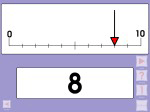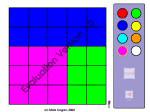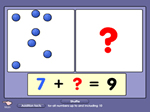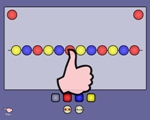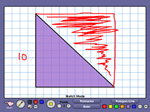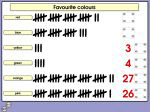§111.13. Mathematics, Grade 1.
(b)Knowledge and skills.
(1) Number, operation, and quantitative reasoning. The student uses whole numbers to describe and compare quantities. The student is expected to:
(A) compare and order whole numbers up to 99 (less than, greater than, or equal to) using sets of concrete objects and pictorial models;
(B) create sets of tens and ones using concrete objects to describe, compare, and order whole numbers;
(C) identify individual coins by name and value and describe relationships among them; and
(D) read and write numbers to 99 to describe sets of concrete objects.
(2) Number, operation, and quantitative reasoning. The student uses pairs of whole numbers to describe fractional parts of whole objects or sets of objects. The student is expected to:
(A) separate a whole into two, three, or four equal parts and use appropriate language to describe the parts such as three out of four equal parts; and
(B) use appropriate language to describe part of a set such as three out of the eight crayons are red.
(3) Number, operation, and quantitative reasoning. The student recognizes and solves problems in addition and subtraction situations. The student is expected to:
(A) model and create addition and subtraction problem situations with concrete objects and write corresponding number sentences; and
(B) use concrete and pictorial models to apply basic addition and subtraction facts (up to 9 + 9 = 18 and 18 – 9 = 9).
(4) Patterns, relationships, and algebraic thinking. The student uses repeating patterns and additive patterns to make predictions. The student is expected to identify, describe, and extend concrete and pictorial patterns in order to make predictions and solve problems.
(5) Patterns, relationships, and algebraic thinking. The student recognizes patterns in numbers and operations. The student is expected to:
(A) use patterns to skip count by twos, fives, and tens;
(B) find patterns in numbers, including odd and even;
(C) compare and order whole numbers using place value;
(D) use patterns to develop strategies to solve basic addition and basic subtraction problems; and
(E) identify patterns in related addition and subtraction sentences (fact families for sums to 18) such as 2 + 3 = 5, 3 + 2 = 5, 5 – 2 = 3, and 5 – 3 = 2.
(6) Geometry and spatial reasoning. The student uses attributes to identify two- and three-dimensional geometric figures. The student compares and contrasts two- and three-dimensional geometric figures or both. The student is expected to:
(A) describe and identify two-dimensional geometric figures, including circles, triangles, rectangles, and squares (a special type of rectangle);
(B) describe and identify three-dimensional geometric figures, including spheres, rectangular prisms (including cubes), cylinders, and cones;
(C) describe and identify two- and three-dimensional geometric figures in order to sort them according to a given attribute using informal and formal language; and
(D) use concrete models to combine two-dimensional geometric figures to make new geometric figures.
(7) Measurement. The student directly compares the attributes of length, area, weight/mass, capacity, and temperature. The student uses comparative language to solve problems and answer questions. The student selects and uses nonstandard units to describe length. The student is expected to:
(A) estimate and measure length using nonstandard units such as paper clips or sides of color tiles;
(B) compare and order two or more concrete objects according to length (from longest to shortest);
(C) describe the relationship between the size of the unit and the number of units needed to measure the length of an object;
(D) compare and order the area of two or more two-dimensional surfaces (from covers the most to covers the least);
(E) compare and order two or more containers according to capacity (from holds the most to holds the least);
(F) compare and order two or more objects according to weight/mass (from heaviest to lightest); and
(G) compare and order two or more objects according to relative temperature (from hottest to coldest).
(8) Measurement. The student understands that time can be measured. The student uses time to describe and compare situations. The student is expected to:
(A) order three or more events according to duration; and
(B) read time to the hour and half-hour using analog and digital clocks.
(9) Probability and statistics. The student displays data in an organized form. The student is expected to:
(A) collect and sort data; and
(B) use organized data to construct real-object graphs, picture graphs, and bar-type graphs.
(10) Probability and statistics. The student uses information from organized data. The student is expected to:
(A) draw conclusions and answer questions using information organized in real-object graphs, picture graphs, and bar-type graphs; and
(B) identify events as certain or impossible such as drawing a red crayon from a bag of green crayons.
(11) Underlying processes and mathematical tools. The student applies Grade 1 mathematics to solve problems connected to everyday experiences and activities in and outside of school. The student is expected to:
(A) identify mathematics in everyday situations;
(B) solve problems with guidance that incorporates the processes of understanding the problem, making a plan, carrying out the plan, and evaluating the solution for reasonableness;
(C) select or develop an appropriate problem-solving plan or strategy including drawing a picture, looking for a pattern, systematic guessing and checking, or acting it out in order to solve a problem; and
(D) use tools such as real objects, manipulatives, and technology to solve problems.
(12) Underlying processes and mathematical tools. The student communicates about Grade 1 mathematics using informal language. The student is expected to:
(A) explain and record observations using objects, words, pictures, numbers, and technology; and
(B) relate informal language to mathematical language and symbols.
(13) Underlying processes and mathematical tools. The student uses logical reasoning. The student is expected to justify his or her thinking using objects, words, pictures, numbers, and technology.





